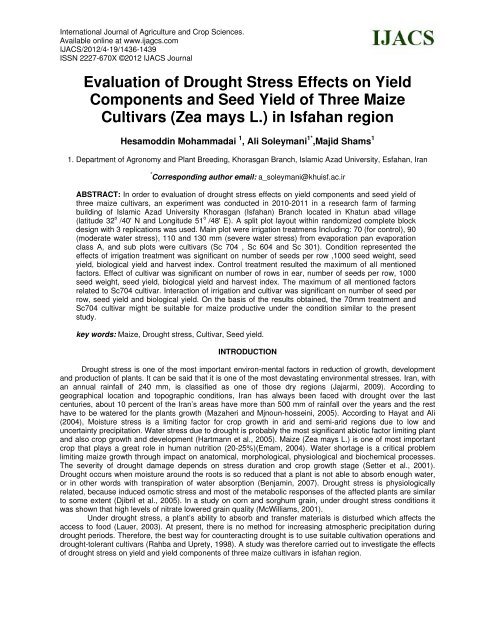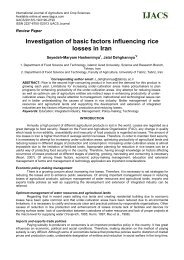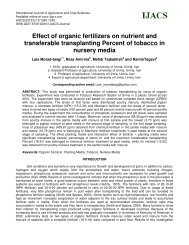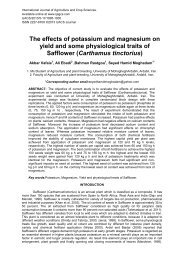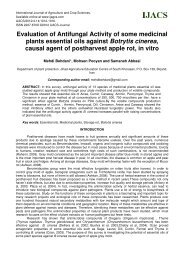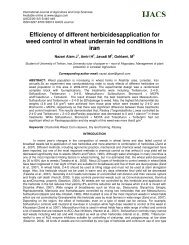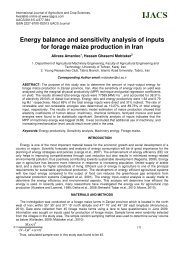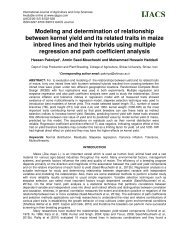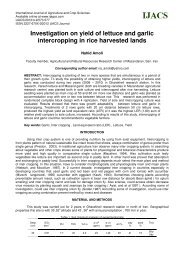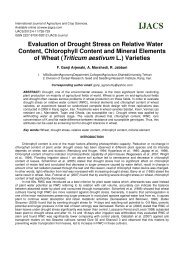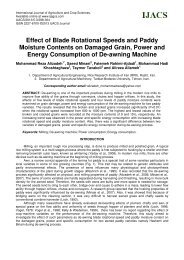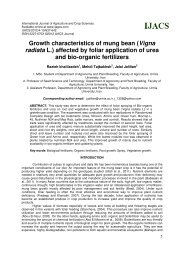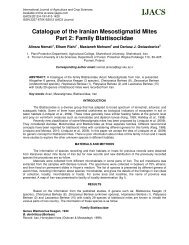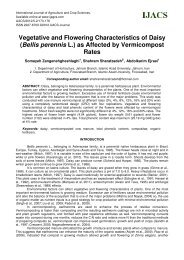1436-1439 - International Journal of Agriculture and Crop Sciences ...
1436-1439 - International Journal of Agriculture and Crop Sciences ...
1436-1439 - International Journal of Agriculture and Crop Sciences ...
Create successful ePaper yourself
Turn your PDF publications into a flip-book with our unique Google optimized e-Paper software.
<strong>International</strong> <strong>Journal</strong> <strong>of</strong> <strong>Agriculture</strong> <strong>and</strong> <strong>Crop</strong> <strong>Sciences</strong>.<br />
Available online at www.ijagcs.com<br />
IJACS/2012/4-19/<strong>1436</strong>-<strong>1439</strong><br />
ISSN 2227-670X ©2012 IJACS <strong>Journal</strong><br />
Evaluation <strong>of</strong> Drought Stress Effects on Yield<br />
Components <strong>and</strong> Seed Yield <strong>of</strong> Three Maize<br />
Cultivars (Zea mays L.) in Isfahan region<br />
Hesamoddin Mohammadai 1 , Ali Soleymani 1* ,Majid Shams 1<br />
1. Department <strong>of</strong> Agronomy <strong>and</strong> Plant Breeding, Khorasgan Branch, Islamic Azad University, Esfahan, Iran<br />
* Corresponding author email: a_soleymani@khuisf.ac.ir<br />
ABSTRACT: In order to evaluation <strong>of</strong> drought stress effects on yield components <strong>and</strong> seed yield <strong>of</strong><br />
three maize cultivars, an experiment was conducted in 2010-2011 in a research farm <strong>of</strong> farming<br />
building <strong>of</strong> Islamic Azad University Khorasgan (Isfahan) Branch located in Khatun abad village<br />
(latitude 32 o /40' N <strong>and</strong> Longitude 51 o /48' E). A split plot layout within r<strong>and</strong>omized complete block<br />
design with 3 replications was used. Main plot were irrigation treatmens Including: 70 (for control), 90<br />
(moderate water stress), 110 <strong>and</strong> 130 mm (severe water stress) from evaporation pan evaporation<br />
class A, <strong>and</strong> sub plots were cultivars (Sc 704 , Sc 604 <strong>and</strong> Sc 301). Condition represented the<br />
effects <strong>of</strong> irrigation treatment was significant on number <strong>of</strong> seeds per row ,1000 seed weight, seed<br />
yield, biological yield <strong>and</strong> harvest index. Control treatment resulted the maximum <strong>of</strong> all mentioned<br />
factors. Effect <strong>of</strong> cultivar was significant on number <strong>of</strong> rows in ear, number <strong>of</strong> seeds per row, 1000<br />
seed weight, seed yield, biological yield <strong>and</strong> harvest index. The maximum <strong>of</strong> all mentioned factors<br />
related to Sc704 cultivar. Interaction <strong>of</strong> irrigation <strong>and</strong> cultivar was significant on number <strong>of</strong> seed per<br />
row, seed yield <strong>and</strong> biological yield. On the basis <strong>of</strong> the results obtained, the 70mm treatment <strong>and</strong><br />
Sc704 cultivar might be suitable for maize productive under the condition similar to the present<br />
study.<br />
key words: Maize, Drought stress, Cultivar, Seed yield.<br />
INTRODUCTION<br />
Drought stress is one <strong>of</strong> the most important environ-mental factors in reduction <strong>of</strong> growth, development<br />
<strong>and</strong> production <strong>of</strong> plants. It can be said that it is one <strong>of</strong> the most devastating environmental stresses. Iran, with<br />
an annual rainfall <strong>of</strong> 240 mm, is classified as one <strong>of</strong> those dry regions (Jajarmi, 2009). According to<br />
geographical location <strong>and</strong> topographic conditions, Iran has always been faced with drought over the last<br />
centuries, about 10 percent <strong>of</strong> the Iran’s areas have more than 500 mm <strong>of</strong> rainfall over the years <strong>and</strong> the rest<br />
have to be watered for the plants growth (Mazaheri <strong>and</strong> Mjnoun-hosseini, 2005). According to Hayat <strong>and</strong> Ali<br />
(2004), Moisture stress is a limiting factor for crop growth in arid <strong>and</strong> semi-arid regions due to low <strong>and</strong><br />
uncertainty precipitation. Water stress due to drought is probably the most significant abiotic factor limiting plant<br />
<strong>and</strong> also crop growth <strong>and</strong> development (Hartmann et al., 2005). Maize (Zea mays L.) is one <strong>of</strong> most important<br />
crop that plays a great role in human nutrition (20-25%)(Emam, 2004). Water shortage is a critical problem<br />
limiting maize growth through impact on anatomical, morphological, physiological <strong>and</strong> biochemical processes.<br />
The severity <strong>of</strong> drought damage depends on stress duration <strong>and</strong> crop growth stage (Setter et al., 2001).<br />
Drought occurs when moisture around the roots is so reduced that a plant is not able to absorb enough water,<br />
or in other words with transpiration <strong>of</strong> water absorption (Benjamin, 2007). Drought stress is physiologically<br />
related, because induced osmotic stress <strong>and</strong> most <strong>of</strong> the metabolic responses <strong>of</strong> the affected plants are similar<br />
to some extent (Djibril et al., 2005). In a study on corn <strong>and</strong> sorghum grain, under drought stress conditions it<br />
was shown that high levels <strong>of</strong> nitrate lowered grain quality (McWilliams, 2001).<br />
Under drought stress, a plant’s ability to absorb <strong>and</strong> transfer materials is disturbed which affects the<br />
access to food (Lauer, 2003). At present, there is no method for increasing atmospheric precipitation during<br />
drought periods. Therefore, the best way for counteracting drought is to use suitable cultivation operations <strong>and</strong><br />
drought-tolerant cultivars (Rahba <strong>and</strong> Uprety, 1998). A study was therefore carried out to investigate the effects<br />
<strong>of</strong> drought stress on yield <strong>and</strong> yield components <strong>of</strong> three maize cultivars in isfahan region.
Intl J Agri <strong>Crop</strong> Sci. Vol., 4 (19), <strong>1436</strong>-<strong>1439</strong>, 2012<br />
MATERIALS AND METHODS<br />
An experiment was conducted on the basis <strong>of</strong> split plot layout with completely r<strong>and</strong>omized block design<br />
with 3 replications. Main plot were irrigation treatmens Including: 70 (for control), 90 (moderate water stress),<br />
110 <strong>and</strong> 130 mm (severe water stress) from evaporation pan evaporation class A, <strong>and</strong> sub plots were cultivars<br />
(Sc 704 , Sc 604 <strong>and</strong> Sc 301). This research was conducted in 2010-2011, at research farm <strong>of</strong> farming building<br />
<strong>of</strong> Islamic Azad University Khorasgan (Isfahan) Branch located in Khatun abad village (latitude 32 o /40' N <strong>and</strong><br />
Longitude 51 o /48' E). Soil texture was silty clay. Long term average precipitation was 120 mm.The soil<br />
preparation consisted <strong>of</strong> mouldboard ploughing (25-30 cm) followed by discing <strong>and</strong> smoothing with a l<strong>and</strong><br />
leveler. On the basis <strong>of</strong> soil analysis, 120 kg ha -1 from triple superphosphate <strong>and</strong> 100 kg ha -1 KSo4, in planting<br />
time were used. Nitrogen as urea (46.6% N) was applied equivalent 300 kg ha -1 . It was added into three equal<br />
portions, the first part was applied in planting time <strong>and</strong> the second part was applied in 2-4 leaf stage, <strong>and</strong> third<br />
part in 6 leaf stage. Other normal agronomic practices for maize production were followed. In each plot, 4 lines<br />
were used, the planting lines number 1 <strong>and</strong> 4 <strong>and</strong> also 0.5 meter from start <strong>and</strong> end <strong>of</strong> lines were omitted <strong>and</strong><br />
the length <strong>of</strong> each line was 5 meter. Number <strong>of</strong> rows in ear, number <strong>of</strong> seeds per row, 1000 seed weight (g),<br />
seed yield (kg ha -1 ), biological yield (kg ha -1 ) <strong>and</strong> harvest index (%),was measured. Mstat-C s<strong>of</strong>tware <strong>and</strong> mean<br />
comparison with Duncan , s test in 5% probability was used.<br />
RESULTS AND DISCUSSION<br />
Irrigation treatment had significant influence on number <strong>of</strong> seeds per row ,1000 seed weight, seed yield,<br />
biological yield <strong>and</strong> harvest index (Table 1). Several studies have shown that seed yield <strong>and</strong> yield components<br />
<strong>of</strong> maize, was markedly affected by irrigation treatments (Moser et al., 2006., Rivera-Hern<strong>and</strong>ez et al., 2010<br />
<strong>and</strong> Cakir., 2004). Effect <strong>of</strong> cultivar was significant on number <strong>of</strong> rows in ear, number <strong>of</strong> seeds per row, 1000<br />
seed weight, seed yield, biological yield <strong>and</strong> harvest index (Table 1). Mostafavi et al. (2011), in a similar<br />
experiment on effects <strong>of</strong> drought stress on Maize hybrids stated variety were significantly affected either on the<br />
yield parameters.<br />
No. <strong>of</strong> rows in ear (NRE)<br />
The highest <strong>of</strong> NRE was achieved with control, but had no significant differences between other<br />
treatments. The lowest NRE related to 130 mm levels <strong>of</strong> evaporation. Sc 704 cultivar has highest NRE but had<br />
no significant differences with Sc 604. The lowest NRE related to Sc 301 (Table 2). Rivera-Hern<strong>and</strong>ez et al.<br />
(2010) reported that although significant differences were observed among irrigation treatments for a variable<br />
number <strong>of</strong> rows per ear, this was the least affected by the rise in soil moisture tension. This suggests that the<br />
number <strong>of</strong> rows per ear is more influenced by heredity factors than by crop management.<br />
No. <strong>of</strong> seeds per row (NSR)<br />
The highest <strong>of</strong> NSR was achieved with control, but had no significant differences with 90 mm. The<br />
lowest NSR related to 130 mm levels <strong>of</strong> evaporation but had no significant differences with 110 mm. Sc 704<br />
cultivar has highest NSR with significant differences from other cultivars <strong>and</strong> the lowest <strong>of</strong> NSR related to Sc<br />
301 (Table 2). Moser et al. (2006) reported that pre-anthesis drought significantly reduced the number <strong>of</strong> kernel<br />
per row.<br />
Table 1. Analysis <strong>of</strong> variance for experimental characteristics.<br />
S.O.V. d.f No. <strong>of</strong> No.<strong>of</strong> 1000seed Seed yield Biological yield HI<br />
rows/ear seeds/row weight<br />
Replication 2 13.19 5.91 128.15 245975.7 901920.52 55.46<br />
* <strong>and</strong> ** Significant at P=0.05 <strong>and</strong> P=0.01 level, respectively in F-test.<br />
**<br />
Irrigation 3 7.80 161.28 * 15027.6 ** 48505490.6 ** 174742355.7 ** 16.88 **<br />
Error (a) 6 3.36 13.107 508.23 162827.3 609368. 6 0.43<br />
Cultivar 2 4.95 * 200.3 ** 1239.40 * 6046435.1 ** 13737452. 6 ** 28.39 **<br />
Irrigation ×Cultivar 6 3.29 43.16 ** 657. 45 880885.9 * 2999682. 5 * 0.38<br />
Error (b) 16 1.36 6.04 255.98 253981.6 1090150.5 3.87<br />
1437
Intl J Agri <strong>Crop</strong> Sci. Vol., 4 (19), <strong>1436</strong>-<strong>1439</strong>, 2012<br />
Table 2. Mean comparison for No.<strong>of</strong> rows/ ear, No.<strong>of</strong> seeds per row, 1000-seed weight (g), seed yield (kg ha -1 ), biological<br />
yield (kg ha -1 ), HI (%).<br />
Treatment No. <strong>of</strong> No.<strong>of</strong> 1000-seed Seed yield Biological HI<br />
Irrigation (mm) (I)<br />
rows/ear seeds/row weight<br />
yield<br />
70 (I1) 17.73 a 28.58 a 368.27 a 8716.2 a 17349.3 a 50.21 a<br />
90 (I2) 16.48 a 26.96 ab 325.48 b 8004.8 b 16206.4 b 49.28 b<br />
110 (I3)<br />
15.80<br />
130 (I4)<br />
a<br />
15.72 a<br />
23.05 bc<br />
19.11 c<br />
292.17 c<br />
275.74 c<br />
5027.3 c<br />
3884.2 d<br />
10379.0 c<br />
8289.1 d<br />
48.42 c<br />
46.99 d<br />
Cultivar (C)<br />
Sc 704 (C1) 16.92 a 28.87 a 327.00 a 7020.1 a 13854.7 a 50.38 a<br />
Sc 604 (C2) 16.67 ab 23.58 b 311.17 b 6572.5 b 13472.8 a 48.46 b<br />
Sc 301 (C3) 15.70 b 20.83 c 308.05 b 5629.5 c 11840.3 b 47.34 b<br />
Irrigation × Cultivar (I×C)<br />
I 1C1 18.63 ab 38.80 a 370.9 a 9746.7 a 18790.8 a 51.87 a<br />
I 1C2 19.17 a 25.77 cd 358.7 a 8644.6 bc 17400.7 abc 49.70 abc<br />
I 1C3 15.43 c 21.23 de 375.3 a 7758.7 c 15860.5 cd 49.10 abcd<br />
I 2C1 16.47 bc 31.23 b 347.9 ab 9086.0 ab 17930.7 ab 50.67 ab<br />
I 2C2 16.93 bc 27.63 bc 305.7 cd 8168.1 c 16500.6 bc 49.43 abcd<br />
I 2C3 16.10 c 21.97 de 322.8 bc 6761.7 d 14180.4 d 47.73 bcd<br />
I 3C1 16.07 c 24.13 cd 300.3 cd 5554.5 e 11120.1 e 50.03 abc<br />
I 3C2 15.37 c 23.03 cd 292. 6cd 5020.0 ef 10380.0 e 48.40 abcd<br />
I 3C3<br />
16.00<br />
I 4C1<br />
I 4C2<br />
I 4C3<br />
c<br />
16.53 bc<br />
15.30 c<br />
15.37 c<br />
22.07 de<br />
21.30 de<br />
17.93 e<br />
18.13 e<br />
283.7 d<br />
289.0 d<br />
287.7 d<br />
250.5 e<br />
4508.5 fg<br />
3695.6 gh<br />
4458.4 fg<br />
3491.4 h<br />
9638.6 e<br />
7580.5 f<br />
9610.6 e<br />
7678.6 f<br />
46.90 bcd<br />
48.93 abcd<br />
46.33 cd<br />
45.70 d<br />
Common letters within each column do not differ significantly.<br />
1000 seed weight<br />
The highest <strong>of</strong> 1000seed weight was achieved control <strong>and</strong> has significantly different from other<br />
treatments, but the lowest <strong>of</strong> 1000seed weight related to 130 mm levels <strong>of</strong> evaporation. The results show that<br />
the highest 1000seed weight was from Sc 704 cultivar <strong>and</strong> other cultivar had no significant differences together<br />
(Table 2). Zenislimer et al., (1995) stated that the drought effect on number <strong>of</strong> grains per <strong>and</strong> 1000-grain<br />
weight, grain yield was reduced.<br />
Seed yield <strong>and</strong> biological yield<br />
The highest <strong>of</strong> seed yield <strong>and</strong> biological yield was achieved in control , <strong>and</strong> had significantly different<br />
from other treatments, but the lowest <strong>of</strong> this factors related to 130 mm levels <strong>of</strong> evaporation. The highest <strong>of</strong><br />
seed yield <strong>and</strong> biological yield was from Sc 704 cultivar <strong>and</strong> the lowet <strong>of</strong> them was from Sc 301 (Table 2).<br />
Osborne et al. (2002) stated that water stress occurring prior to silking, decreased yield by 22.1 <strong>and</strong><br />
15.1% for the dry l<strong>and</strong> (no additional irrigation except that needed to avoid complete crop loss) <strong>and</strong> 0.5 ET<br />
irrigation treatments. Oktem (2008) reported that the relationships between fresh ear yields <strong>and</strong> the irrigation<br />
treatments were statistically significant (P
Intl J Agri <strong>Crop</strong> Sci. Vol., 4 (19), <strong>1436</strong>-<strong>1439</strong>, 2012<br />
the maximum <strong>of</strong> all mentioned factors, was achieved in Sc 704 cultivar, that is consistent with Mostafavi et al.<br />
(2011) result , s. Then, on the basis <strong>of</strong> the results obtained, this finding is in agreement with other reports<br />
suggesting that the 70mm levels <strong>of</strong> evaporation treatment <strong>and</strong> Sc704 cultivar might be suitable for maize<br />
productive under the condition similar to the present study.<br />
REFERENCES<br />
Benjamin, J. 2007. Effects <strong>of</strong> water stress on corn production. USDA Agricultural Research Service, Akron, pp: 3-5.<br />
Cakir R .2004. Effect <strong>of</strong> water stress at different development stages on vegetative <strong>and</strong> reproductive growth <strong>of</strong> corn. Filed. <strong>Crop</strong>s. Res., 89:<br />
1-16.<br />
Djibril S, Mohamed OK, Diaga D, Diégane D, Abaye BF, Maurice S, Alain B. 2005. Growth <strong>and</strong> development <strong>of</strong> date palm (Phoenix<br />
dactylifera L.) seedlings under drought <strong>and</strong> salinity stresses. Afr. J. Biotechnol., 4(9): 968-972.<br />
Du T, Kang S, Zhang J, Li F, Hu X. 2006. Yield <strong>and</strong> physiological responses <strong>of</strong> cotton to partial root-zone irrigation in the oasis field <strong>of</strong><br />
northwest China. Agricultural Water Management 84: 41-52.<br />
Emam Y. 2004. Agronomy <strong>of</strong> cereal crops (2rd edn.).University <strong>of</strong> Shiraz Press, Shiraz, Iran.<br />
Hartmann T, College M, Lumsden P. 2005. Responses <strong>of</strong> different varieties <strong>of</strong> Lolium perenne to salinity. Annual Conference <strong>of</strong> the Society<br />
for Experimental Biology,Lancashire.<br />
Hayat R, Ali S. 2004. Water absorption by synthetic polymer (Aquasorb) <strong>and</strong> its effect on soil properties <strong>and</strong> tomato yield. Int J Agric Biol. 6:<br />
998–1002.<br />
Jajarmi V. 2009. Effect <strong>of</strong> water stress on germination indices in seven wheat cultivar.World Acad. Sci. Eng. Technol., 49: 105-106.<br />
Lauer, J. 2003. What happens within the corn plant when Drought occurse CornAgronomist, 10(22): 153-155.<br />
Mazaheri D, Majnoun-Hosseini N. 2005. Fundamental <strong>of</strong> agronomy (4th ed). Tehran University Publication. (In Persian).<br />
McWilliams, D. 2001. Drought strategies for corn <strong>and</strong> grain Sorghum. Extension agronomist, Department <strong>of</strong> Extension Plant <strong>Sciences</strong>, New<br />
Mexico State University, Las Cruces, New Mexico.<br />
Moser SB, Feil B, Jampatong S, Stamp P. 2006. Effect <strong>of</strong> pre-anthesis drought nitrogen fertilizer rate <strong>and</strong> variety on grain yield, yield<br />
components <strong>and</strong> harvest index <strong>of</strong> tropical maize. Agric. Water Manage., 81: 41-58.<br />
Mostafavi KH, Sadeghi Geive H, Dadresan M, Zarabi M. 2011. Effects <strong>of</strong> drought stress on germination indices <strong>of</strong> corn hybrids (Zea mays<br />
L.). <strong>International</strong> J. Agric. Sci.,1 (2):10-18.<br />
Oktem A. 2008. Effect <strong>of</strong> water shortage on yield <strong>and</strong> protein <strong>and</strong> mineral compositions <strong>of</strong> drip-irrigated sweet corn in sustainable<br />
agricultural systems. Agric. Water Manage., 95:1003-1010.<br />
Osborne SL, Schepers JS, Francis DD, Schlemer MR. 2002. Use <strong>of</strong> spectral radiance to estimate in-season biomass <strong>and</strong> grain yield in<br />
nitrogen <strong>and</strong> water-stressed corn. <strong>Crop</strong> Sci., 42: 165-171.<br />
Rahba, B. K., <strong>and</strong> D.C. Uprety. 1998. Effects <strong>of</strong> elevated CO2 <strong>and</strong> moisture stress on maize. Photosynthetica. 35(4):597-602.<br />
Rivera-Hern<strong>and</strong>ez B, Carrillo-Avila E, Obrador-Olan JJ, Juarez-Lopez JF, Aceves-Navarro LA. 2010. Morphological quality <strong>of</strong> sweet corn<br />
(Zea mays L.) ears as response to soil moisture tension <strong>and</strong> phosphate fertilization in Campeche, Mexico. Agric. WaterManage.<br />
97(9): 1365-1374.<br />
Setter TL, Flannigan B, Melkonian J. 2001. Loss <strong>of</strong> kernel set due to water deficit <strong>and</strong> shade in maize. <strong>Crop</strong> Sci. 41:1530-1540.<br />
Stone PJ, Wilson DR, Reid JB, Gillespie RN. 2001. Water deficit effects on sweet corn. . Water use, radiation use efficiency growth <strong>and</strong><br />
yield. Aust. J. Agr. Res., 52(1): 103-113.<br />
Tang LS, li Y, Zhang J. 2005. Physiological <strong>and</strong> yield response <strong>of</strong> cotton under partial root zone irrigation. Field <strong>Crop</strong>s Res. 94: 214-223.<br />
Wakrim R, Wahbi S, Tahi H, Aganchich B, Serraj R. 2005. Comparative effects <strong>of</strong> partial root drying (PRD) <strong>and</strong> regulated deficit irrigation<br />
(RDI) on water relations <strong>and</strong> water use efficiency in common bean (Phaseolus vulgaris L.). <strong>Agriculture</strong>, Ecosystems <strong>and</strong><br />
Environment. 106: 275–287.<br />
Zinselmeier, C., M.J. Lauer <strong>and</strong> J.S. boyer. 1995a. Reversing drought-induced losses in grain yield: sucrose Maintains embryo growth in<br />
maize. <strong>Crop</strong> Sci., 35: 1390-1400.<br />
<strong>1439</strong>


